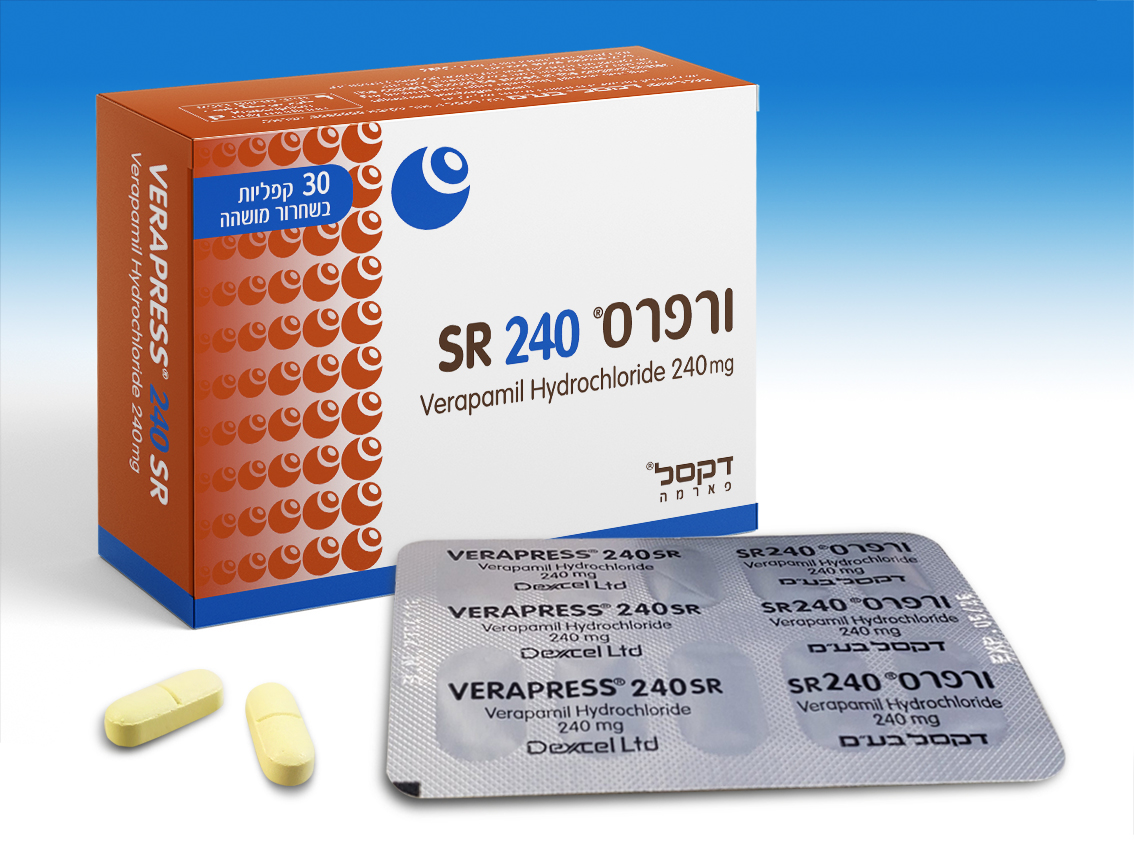Quest for the right Drug

ורפרס 240 SR VERAPRESS 240 SR (VERAPAMIL HYDROCHLORIDE)
תרופה במרשם
תרופה בסל
נרקוטיקה
ציטוטוקסיקה
צורת מתן:
פומי : PER OS
צורת מינון:
קפליות : CAPLETS
עלון לרופא
מינוניםPosology התוויות
Indications תופעות לוואי
Adverse reactions התוויות נגד
Contraindications אינטראקציות
Interactions מינון יתר
Overdose הריון/הנקה
Pregnancy & Lactation אוכלוסיות מיוחדות
Special populations תכונות פרמקולוגיות
Pharmacological properties מידע רוקחי
Pharmaceutical particulars אזהרת שימוש
Special Warning עלון לרופא
Physicians Leaflet
Pharmacological properties : תכונות פרמקולוגיות
Pharmacodynamic Properties
5.1 Pharmacodynamic properties Pharmacotherapeutic group: Selective calcium channel blockers with direct cardiac effects, phenylalkylamine derivatives. ATC-Code: C08DA01 Verapamil, a phenylalkylamine calcium antagonist, has a balanced profile of cardiac and peripheral effects. It lowers heart rate, increases myocardial perfusion and reduces coronary spasm. In a clinical study in patients after myocardial infarction, verapamil reduced total mortality, sudden cardiac death and reinfarction rate. Verapamil reduces total peripheral resistance and lowers high blood pressure by vasodilation, without reflex tachycardia. Because of its use-dependent action on the voltage-operated calcium channel, the effects of verapamil are more pronounced on high than on normal blood pressure. As early as day one of treatment, blood pressure falls; the effect is found to persist also in long-term therapy. Verapamil is suitable for the treatment of all types of hypertension: for monotherapy in mild to moderate hypertension; combined with other antihypertensives (in particular with diuretics and, according to more recent findings, with ACE inhibitors) in more severe types of hypertension. In hypertensive diabetic patients with nephropathy, verapamil in combination with ACE inhibitors led to a marked reduction of albuminuria and to an improvement of creatinine clearance.
Pharmacokinetic Properties
5.2 Pharmacokinetic properties Verapamil hydrochloride is a racemic mixture consisting of equal portions of the R-enantiomer and the S-enantiomer. Verapamil is extensively metabolized. Norverapamil is one of 12 metabolites identified in urine, has 10 to 20% of the pharmacologic activity of verapamil and accounts for 6% of excreted drug. The steady-state plasma concentrations of norverapamil and verapamil are similar. Steady state after multiple once daily dosing is reached after three to four days. Absorption Greater than 90% of verapamil is rapidly absorbed from the small intestine after oral administration. Mean systemic availability of the unchanged compound after a single dose of SR verapamil is approximately 33%, owing to an extensive hepatic first-pass metabolism. Bioavailability is about two times higher with repeated administration. Peak verapamil plasma levels are reached four to five hours after SR administration. The peak plasma concentration of norverapamil is attained approximately five hours after SR administration. The presence of food has no effect on the bioavailability of verapamil. Distribution Verapamil is widely distributed throughout the body tissues, the volume of distribution ranging from 1.8–6.8 L/kg in healthy subjects. Plasma protein binding of verapamil is approximately 90%. Metabolism Verapamil is extensively metabolized. In vitro metabolic studies indicate that verapamil is metabolized by cytochrome P450 CYP3A4, CYP1A2, CYP2C8, CYP2C9 and CYP2C18. In healthy men, orally administered verapamil hydrochloride undergoes extensive metabolism in the liver, with 12 metabolites having been identified, most in only trace amounts. The major metabolites have been identified as various N and O-dealkylated products of verapamil. Of these metabolites, only norverapamil has any appreciable pharmacological effect (approximately 20% that of the parent compound), which was observed in a study with dogs. Elimination Following oral administration, the elimination half-life is three to seven hours. Approximately 50% of an administered dose is eliminated renally within 24 hours, 70% within five days. Up to 16% of a dose is excreted in the feces. About 3% to 4% of renally excreted drug is excreted as unchanged drug. The total clearance of verapamil is nearly as high as the hepatic blood flow, approximately 1 L/h/kg (range: 0.7-1.3 L/h/kg). Special Populations Geriatric: Aging may affect the pharmacokinetics of verapamil given to hypertensive patients. Elimination half-life may be prolonged in the elderly. The antihypertensive effect of verapamil was found not to be age-related. Renal insufficiency: Impaired renal function has no effect on verapamil pharmacokinetics, as shown by comparative studies in patients with end-stage renal failure and subjects with healthy kidneys. Verapamil and norverapamil are not significantly removed by hemodialysis. Hepatic insufficiency: The half-life of verapamil is prolonged in patients with impaired liver function owing to lower oral clearance and a higher volume of distribution.

שימוש לפי פנקס קופ''ח כללית 1994
Supraventricular arrhythmias, paroxysmal tachycardia, atrial fibrillation and flutter, angina pectoris, mild to moderate hypertension
תאריך הכללה מקורי בסל
01/01/1995
הגבלות
תרופה שאושרה לשימוש כללי בקופ'ח
מידע נוסף
עלון מידע לצרכן
28.06.16 - עלון לצרכן אנגלית 15.06.22 - עלון לצרכן אנגלית 15.06.22 - עלון לצרכן עברית 28.06.16 - עלון לצרכן ערבית 15.06.22 - עלון לצרכן ערבית 12.10.22 - עלון לצרכן עברית 29.11.22 - עלון לצרכן אנגלית 29.11.22 - עלון לצרכן עברית 29.11.22 - עלון לצרכן ערבית 02.05.22 - החמרה לעלון 15.06.22 - החמרה לעלון 07.12.15 - החמרה לעלון 12.10.22 - החמרה לעלון 29.11.22 - החמרה לעלון 10.05.24 - החמרה לעלוןלתרופה במאגר משרד הבריאות
ורפרס 240 SR